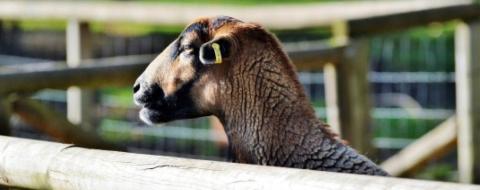As New Hampshire becomes more urban, the potential for conflict between the farming and non-farming communities increases. By using best management practices*, farmers can greatly reduce or eliminate problems arising from odors and flies, pesticide drift, contamination of surface and ground waters, and damage to neighboring crops. Following best management practices can help eliminate problems that arise between farming activities and other land uses in urban environments.
Farming activities may involve full-time, part-time or backyard farmers. Existing commercial farms, as defined by RSA 21:34-a, are protected by the Right to Farm Law; RSA chapter 432. This allows for properly managed agricultural enterprises to continue operating in residential areas.
Housing
Farm animals need some kind of shelter to escape the elements. It is commonly thought that winter is the most important time to provide shelter, but an animal’s natural coat can allow them to tolerate much colder temperatures than people can. Summer heat can be harder on animals than winter if shade is not available to them, either by trees or structures if they are out on pasture. Similarly, lack of ventilation in a barn or building can also be detrimental to animal health. Many livestock animals like pigs and rabbits do not sweat, which increases the risk of heat stroke and decreases overall production. A simple, three-sided shelter with an open front will meet the needs of many farm animals on pasture and is often the building of choice to raise healthy livestock. When designing a three-sided animal shelter, make sure the open side faces south, away from prevailing winds. Locate the structure on an elevated, well-drained site and keep winter access in mind for feeding and water handling.
*Refer to the Manual of Best Management Practices (BMPs) for Agriculture in New Hampshire for specific guidelines on proper animal waste handling and barnyard management. For a print copy of the manual, contact the New Hampshire Department of Agriculture, Markets & Food, at 603-271-3551.

There are several factors to consider when planning adequate livestock shelter in cold weather:
Air quality: Animal shelters should be open, providing natural ventilation, or enclosed, using fans and proper air inlets around the ceiling perimeter to provide good air circulation. Tight buildings result in a buildup of respiration gases, and animal odors, which can irritate the animal’s lungs and cause pneumonia. Dangerous ammonia levels1 can also build up and lead to suffocation death of animals and their caretakers.
Drafts: Animals can stand cold temperatures, but you should protect them from drafts. Constructing panels in front of an open building can reduce drafts. Consider drafts at animal height, not person height. When animals are allowed to run loose in a pen instead of being hitched, they will search for the most comfortable spots as needed.
Dry bedding area: Animals will be far more comfortable in the cold if they have clean, dry bedding. A thick, dry bed provides insulation from the cold ground and decreases the amount of energy the animal has to expend to keep warm. Shelter from the snow and rain allows an animal’s coat to remain dry, which provides maximum insulating value.
Fresh water2: All animals need water to survive. Under cold conditions, provide fresh water often or use freeze-proof watering devices. Animals will drink more when water is 50°F.
Adequate food: Animals can endure severe cold temperatures if they eat enough food (energy) to maintain their energy reserves (body fat). Animals need energy for growth, maintenance and production. Extra energy is expended to keep warm. Therefore, they will require additional amounts of good quality feed during cold weather. For herbivores, free choice hay in hay racks should be supplied in addition to a species-appropriate concentrate or prepared ration.
Space
Refer to the table on the next page for estimates on the space needs of various animals for confinement, exercise yards, and pasture. If zero pasturing is practiced, you will have to provide adequate purchased feed, have an exercise yard, and develop a sound plan for manure management.
If you do provide pasture, the number of animals it will support per acre depends on soil fertility and environmental considerations. These conditions vary widely across the state. Rotational grazing3—the practice of sectioning off a piece of a pasture with electric fencing and confining animals in that section, then repositioning the fence and moving animals to another section depending on grass growth— prevents pastures from being overgrazed, supports best management practices to control internal parasite loads, and will support more animals than a set stock system.
The following table lists the suggested minimum space required, housing types and fencing needs of various farm species, along with the number of animals that will meet the food, fiber, recreation and other needs of an average family farmstead. This is a rough guide. For more information and guidance, contact your local County Field Specialist.
Suggested Space and Housing Guidelines for Fully Mature Farm Animals
Animal: Horse
Unit: 1 horse
Enclosed Housing Area/ Animal: Tie stalls 45 sq. ft.; 5' x 9', Box stall 12' x 8' or 10' by 10'
Exercise Yard Area/ Animal: 200 sq. ft.
Pasture Area/ Animal: 1-2 acres
Type of Housing and Boundary Setback: Enclosed ventilated barn or open 3-sided barn. Setback 50 ft.
Fencing: Electric, Wooden rail, Woven wire
Family Needs: 1 horse per family member
Animal: Beef Cow
Unit: 1 cow
Enclosed Housing Area/ Animal: 75- 100 sq. ft.
Exercise Yard Area/ Animal: 100- 125 sq. ft.
Pasture Area/ Animal: 1- 2 acres
Type of Housing and Boundary Setback: Open front 3-sided barn. Setback 50 ft.
Fencing: Barbed wire, Electric, Woven wire0 ft.
Family Needs: 1/2 - 1 beef animal/ year; raise 2 animals/yr to provide continuous supply
Animal: Dairy Cow
Unit: 1 cow
Enclosed Housing Area/ Animal: 75- 100 sq. ft.
Exercise Yard Area/ Animal: 100- 125 sq. ft.
Pasture Area/ Animal: 1- 2 acres
Type of Housing and Boundary Setback: Open front 3-sided barn, free-stall or enclosed stanchion barn. Setback 50 ft.
Fencing: Barbed wire, Electric, Woven wire0 ft.
Family Needs: 1- 2 cows
Animal: Dairy Goat
Unit: 1 goat
Enclosed Housing Area/ Animal: 20- 25 sq. ft.
Exercise Yard Area/ Animal: 50 sq. ft.
Pasture Area/ Animal: 0.2-0.3 acres
Type of Housing and Boundary Setback: Enclosed barn with removable side panels or windows. Setback 50 ft.
Fencing: Electric, Woven wire
Family Needs: 2-3 goats
Animal: Pig
Unit: 1 pig
Enclosed Housing Area/ Animal: 48 sq. ft. with exercise yard; 100 sq. ft. without exercise yard
Exercise Yard Area/ Animal: 200 sq. ft.
Pasture Area/ Animal: 12-14 sows/acre/ rotational pasture ft.
Type of Housing and Boundary Setback: Enclosed barn, huts, shed, hutches or lean-to. Setback 50 ft.
Fencing: Electric, Plank rail
Family Needs: 2 pigs per year
Animal: Sheep
Unit: 1 sheep
Enclosed Housing Area/ Animal: 20-25 sq. ft.
Exercise Yard Area/ Animal: 50 sq. ft.
Pasture Area/ Animal: 0.2-0.3 acres
Type of Housing and Boundary Setback: Open front 3-sided shed. Setback 50 ft.
Fencing: Electric, Woven wire
Family Needs: 6 sheep
Animal: Hen
Unit: 1 hen
Enclosed Housing Area/ Animal: 3- 4 sq. ft.
Exercise Yard Area/ Animal: 10 sq. ft.
Pasture Area/ Animal: ---
Type of Housing and Boundary Setback: Enclosed barn. Setback 50 ft.
Fencing: Chicken wire
Family Needs: 6 hens
Animal: Broiler
Unit: 1 broiler
Enclosed Housing Area/ Animal: 3-4 sq. ft.
Exercise Yard Area/ Animal: ---
Pasture Area/ Animal: ---
Type of Housing and Boundary Setback: Enclosed barn. Setback 50 ft.
Fencing: ---
Family Needs: 24 broilers
Animal: Turkey
Unit: 1 turkey
Enclosed Housing Area/ Animal: 6 sq. ft.
Exercise Yard Area/ Animal: 20 sq. ft.
Pasture Area/ Animal: 100 sq. ft.
Type of Housing and Boundary Setback: Enclosed barn. Setback 50 ft.
Fencing: Chicken wire
Family Needs: 12 turkeys
Note to municipal planners: The minimum space and housing guidelines in the chart apply to both commercial
farms and backyard operations. However, you should not apply the numbers of animals suggested in the "Family
Needs" category to commercial farms when drafting ordinances regulating agriculture in your community.

Created: June, 2009
Updated: December 2017
Updated: March 2023
Visit our website:
extension.unh.edu
UNH Cooperative Extension brings information and education into the communities of the Granite State to help make New Hampshire's individuals, businesses, and communities more successful and its natural resources healthy and productive. For 100 years, our specialists have been tailoring contemporary, practical education to regional needs, helping create a well-informed citizenry while strengthening key economic sectors. The University of New Hampshire Cooperative Extension is an equal opportunity educator and employer. University of New Hampshire, U.S. Department of Agriculture and N.H. counties cooperating.
1Ammonia Emissions and Safety, Alberta Food and Rural Development
2Livestock Water Requirements, North Dakota State Univeristy.
3Four Steps to Rotational Grazing, PennState Extension
About the Authors
Original fact sheet written by
David Seavey and John Porter,
Extension Educators, June
2009. Updated by Dot Perkins,
Field Specialist, Dairy Forages
and Livestock Team, December
2017. Updated by Kendall Kunelius,
Field Specialist, Agriculture
Business Management, March 2023.
For More Information
State Office
Taylor Hall
59 College Rd.
Durham, NH 03824
http://extension.unh.edu
Education Center and Information Line
answers@unh.edu
1-877-EXT-GROW
(1-877-398-4769)
9 a.m. to 2 p.m. M-F
extension.unh.edu/askunhextensionl>
Note to municipal planners: The minimum space and housing guidelines in the chart apply to both commercial farms and backyard operations. However, you should not apply the numbers of animals suggested in the “Family Needs” category to commercial farms when drafting ordinances regulating agriculture in your community.
Extension Services & Tools That Help NH Farmers Grow
Newsletters: Choose from our many newsletters for production agriculture
Receive Pest Text Alerts - Text UNHIPM to (866) 645-7010



